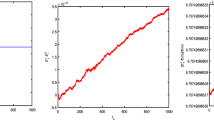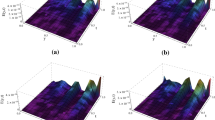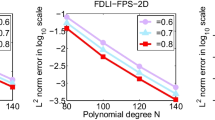Abstract
In this paper, a sine pseudo-spectral-difference scheme that preserves the discrete mass and energy is presented and analyzed for the coupled Gross–Pitaevskii equations with Dirichlet boundary conditions in several spatial dimensions. The Crank–Nicolson finite difference method is employed for approximating the time derivative, and the second-order sine spectral differentiation matrix is deduced and applied in spatial discretization. Without any restrictions on the grid ratios, optimal error estimates are established by utilizing the discrete energy method and the equivalence of (semi-)norms. An accelerated algorithm is developed to speed up the numerical implementation with the help of fast sine transform. Numerical examples are tested to confirm the effectiveness and high accuracy of the method.
Similar content being viewed by others
References
Abo-Shaeer, J.R., Raman, C., Vogels, J.M., Ketterle, W.: Observation of vortex lattices in Bose-Einstein condensates. Science 292, 476–479 (2001)
Wall, D.S., Matthews, M.R., Ensher, J.R., Wieman, C.E., Cornell, E.A.: Dynamics of component separation in a binary mixture of Bose-Einstein condensates. Phys. Rev. Lett. 81, 1539–1542 (1998)
Matthews, M.R., Anderson, B.P., Haljan, P.C., Hall, D.S., Wieman, C.E., Cornell, E.A.: Vortices in a Bose-Einstein condensate. Phys. Rev. Lett. 83, 201–202 (1999)
Fetter, A.L., Svidzinsky, A.A.: Vortices in a trapped dilute Bose-Einstein condensate. J. Phys. Condens. Matter 13, R135–R194 (2001)
Madison, K.W., Chevy, F., Wohlleben, W., Dalibard, J.: Vortex formation in a stirred Bose-Einstein condensate. Phys. Rev. Lett. 47, 2715–2723 (2000)
Pitaevskii, L.P., Stringary, S.: Bose-Einstein condensation. Clarendon Press, New York (2003)
Bao, W.Z., Cai, Y.Y.: Ground states of two-component Bose-Einstein condensates with an internal atomic Josephson junction. East Asian J. Appl. Math. 1, 49–81 (2011)
Ismail, M.S.: Numerical solution of coupled nonlinear Schrödinger equation by Galerkin method. Math. Comput. Simul. 78, 532–547 (2008)
Sonnier, W.J., Christov, C.I.: Strong coupling of Schrödinger equations: Conservative scheme approach. Math. Comput. Simul. 69, 514–525 (2005)
Sun, Z.Z., Zhao, D.D.: On the \(L_{\infty }\) convergence of a difference scheme for coupled nonlinear Schrödinger equations. Comput. Math. Appl. 59, 3286–3300 (2010)
Wang, T.C.: Optimal point-wise error estimate of a compact difference scheme for the coupled Gross-Pitaevskii equations in one dimension. J. Sci. Comput. 59, 158–186 (2014)
Wang, T.C.: A linearized, decoupled and energy-preserving compact finite difference scheme for the coupled nonlinear Schrödinger equations. Numer. Methods Part. Diff. Equ. 33, 840–867 (2017)
Bao, W.Z., Shen, J.: A fourth-order time-splitting Laguerre-Hermite pseudospectral method for Bose-Einstein condensates. SIAM J. Sci. Comput. 26, 2010–2028 (2005)
Wang, H.Q.: A time-splitting spectral method for coupled Gross-Pitaevskii equations with applications to rotating Bose-Einstein-condensates. J. Comput. Appl. Math. 205, 88–104 (2007)
Zhang, Y.Z., Bao, W.Z., Li, H.L.: Dynamics of rotating two-component Bose-Einstein condensates and its efficient computation. Phys. D 234, 49–69 (2007)
Ming, J., Tang, Q.L., Zhang, Y.Z.: An efficient spectral method for computing dynamics of rotating two-component Bose-Einstein condensates via coordinate transformation. J. Comput. Phys. 258, 538–554 (2014)
Bao, W.Z., Cai, Y.Y.: Optimal error estimates of finite difference methods for the Gross-Pitaevskii equation with angular momentum rotation. Math. Comput. 82, 99–128 (2013)
Bao, W.Z., Cai, Y.Y.: Mathematical theory and numerical methods for Bose-Einstein condensation. Kinet. Relat Mod. 6, 1–135 (2013)
Wang, T.C., Zhao, X.F.: Optimal \(l^{\infty }\) error estimates of finite difference methods for the coupled Gross-Pitaevskii equations in high dimensions. Sci. China Math. 57, 2189–2214 (2014)
Wang, T.C., Jiang, J.P., Xiang, X.: Unconditional and optimal H1 error estimate of a Crank-Nicolson finite difference scheme for the Gross-Pitaevskii equation with an angular momentum rotation term. J. Math. Anal. Appl. 459, 945–958 (2018)
Bao, W.Z., Dong, X.C., Zhao, X.F.: An exponential wave integrator pseudospectral method for the Klein-Gordon-Zakharov sysytem. SIAM J. Sci. Comput. 35, A2903–A2927 (2013)
Zhao, X.F.: On error estimates of an exponential wave integrator sine pseudospectral method for the Klein-Gordon-Zakharov sysytem. Numer. Methods Part. Diff. Equ. 32, 266–291 (2016)
Dong, X.C.: Stability and convergence of trigonometric integrator pseduospectral discretization for N-coupled nonlinear Klein-Gordon equations. Appl. Math. Comput. 232, 752–765 (2014)
Li, X., Zhang, L.M.: Error estimates of a trigonometric integrator sine pseudo-spectral method for the extended Fisher-Kolmogorov equation. Appl. Numer. Math. 131, 39–53 (2018)
Gong, Y.Z., Cai, J.X., Wang, Y.S.: Multi-symplectic Fourier pseudospectral method for the Kawahara equation. Commun. Comput. Phys. 16, 35–55 (2014)
Gong, Y.Z., Wang, Q., Wang, Y.S., Cai, J.X.: A conservative Fourier pseudo-spectral method for the nonlinear Schrödinger equation. J. Comput. Phys. 328, 354–370 (2017)
Wang, T.C., Guo, B.L., Xu, Q.B.: Fourth-order compact and energy conservative difference schemes for the nonlinear Schrödinger equation in two dimensions. J. Comput. Phys. 243, 382–399 (2013)
Browder, F.E.: Existence and uniqueness theorems for solutions of nonlinear boundary value problems. Application of nonlinear partial differential equations. In: Finn, R. (ed.) Proc. Symp. Appl. Math., vol. 17, pp 24–49. AMS, Providence (1965)
Zhang, Y.N., Sun, Z.Z., Wang, T.C.: Convergence analysis of a linearized Crank-Nicolson scheme for the two-dimensional complex Ginzburg-Landau equation. Numer. Methods Part. Diff. Equ. 29, 1487–1503 (2013)
Wang, T.C., Zhao, X.F., Jiang, J.P.: Unconditional and optimal H2-error estimates of two linear and conservative finite difference schemes for the Klein-Gordon-Schrödinger equation in high dimensions. Adv. Comput. Math. 5, 1–27 (2017)
Canuto, C., Quarteroni, A.: Approximation results for orthogonal polynomials in Sobolev spaces. Math. Comput. 38, 67–86 (1982)
Zhou, Y.L.: Application of Discrete Functional Analysis to the Finite Difference Methods. International Academic Publishers, Beijing (1990)
Acknowledgments
The authors would like to thank the anonymous referees for their careful reading and many constructive comments and suggestions of the manuscript.
Funding
X Li is supported by a grant no. KJ2018A0523 from the University Natural Science Research Key Project of Anhui Province.
Author information
Authors and Affiliations
Corresponding author
Additional information
Communicated by: Jan Hesthaven
Publisher’s note
Springer Nature remains neutral with regard to jurisdictional claims in published maps and institutional affiliations.
Appendices
Appendix A: Proof of Lemma 2.1
To obtain the second-order SSDM, the following lemma needs to be verified at first.
Lemma A.1 1
Denote 𝜃x := μx(x − xj), 𝜃y := μy(y − yk), \(\theta _{x}^{\prime }:=\mu _{x}(x+x_{j}-2a)\), \(\theta _{y}^{\prime }:=\mu _{y}(y+y_{k}-2c)\). The interpolation basis functions can be reformulated as:
with \(\mathfrak {S}(N,\mu ,\theta ):=\frac {1}{2N}\big [\sin \limits (N\theta )\cot \frac {\theta }{2}-\cos \limits (N\theta )\big ]\).
Proof
We just prove the assertion of Xj(x). The other one can be deduced correspondingly. Applying the prosthaphaeresis formula and the definitions of 𝜃x and \(\theta _{x}^{\prime }\), (??) implies that
Invoking to the identity
we obtain the desired results and complete the proof of Lemma A.1. □
Proof Proof of Lemma 2.1
For simplicity, we also verify the assertion in the x-direction and the assertion of y-direction is equally acceptable. By means of the above lemma, the second-order derivative of Xj(x) can be given by:
where the second-order derivative \(\mathfrak {\ddot {S}}(N,\mu ,\theta )\) is obtained directly by:
To obtain the second-order SSDM, we divide the proof into two cases:
- (i)
If x = xp≠xj, the definitions of 𝜃x and \(\theta _{x}^{\prime }\) lead to:
$$ \begin{array}{@{}rcl@{}} \sin(N_{x}\theta_{x})=\sin(N_{x}\theta_{x}^{\prime})=0,\ \ \cos(N_{x}\theta_{x})=\cos(N_{x}\theta_{x}^{\prime})=(-1)^{j+p}. \end{array} $$Substituting the results into \(\mathrm {X}_{j}^{\prime \prime }(x)\) and using the definition of μx, for j≠p, one has:
$$ \begin{array}{@{}rcl@{}} \mathrm{X}_{j}^{\prime\prime}(x_{p})&=&(-1)^{j+p+1}\frac{{\mu_{x}^{2}}}{2}(\csc^{2}\frac{\theta_{x}}{2}-\csc^{2}\frac{\theta_{x}^{\prime}}{2})\\ &=&(-1)^{j+p+1}\frac{{\mu_{x}^{2}}}{2}\bigg[\csc^{2}\big(\frac{\mu_{x}}{2}(j-p)h_{x}\big)- \csc^{2}\big(\frac{\mu_{x}}{2}(j+p)h_{x}\big)\bigg]. \end{array} $$This completes the proof of the first case of (??).
- (ii)
If x = xp = xj, the first term of \(\mathrm {X}_{j}^{\prime \prime }(x)\), i.e. \(\mathfrak {\ddot {S}}(N_{x},\mu _{x},\theta _{x})\) equals to the following:
$$ \begin{array}{@{}rcl@{}} &\frac{\frac{{\mu_{x}^{2}}}{4N_{x}}\sin(N_{x}\theta_{x})\cos\frac{\theta_{x}}{2}-\frac{N_{x}{\mu_{x}^{2}}}{2}\sin(N_{x}\theta_{x})\cos\frac{\theta_{x}}{2}\sin^{2} \frac{\theta_{x}}{2}-\frac{{\mu_{x}^{2}}}{2}\cos(N_{x}\theta_{x})\sin\frac{\theta_{x}}{2} }{\sin^{3}\frac{\theta_{x}}{2}}+\frac{N_{x}{\mu_{x}^{2}}}{2}\cos(N_{x}\theta_{x}). \end{array} $$We apply Taylor’s expansion for each term of the numerator and find:
$$ \begin{array}{@{}rcl@{}} &\sin(N_{x}\theta_{x})\cos\frac{\theta_{x}}{2}=\Big(N_{x}\theta_{x} -\frac{(N_{x}\theta_{x})^{3}}{3!}+\cdots\Big)\Big(1-\frac{(\frac{\theta_{x}}{2})^{2}}{2!}+\cdots\Big)\\ &\ \ \ \ \ \ \ \ \ \ \ \quad \ \ \ \ \ \ \ \ =N_{x}\theta_{x}-N_{x}\big(\frac{\theta_{x}}{2}\big)^{3}-\frac{4{N_{x}^{3}}}{3}\big(\frac{\theta_{x}}{2}\big)^{3}+O\big({\theta_{x}^{5}}\big),\\ &\sin(N_{x}\theta_{x})\cos\frac{\theta_{x}}{2}\sin^{2}\frac{\theta_{x}}{2}=\Big(N_{x}\theta_{x} -\frac{(N_{x}\theta_{x})^{3}}{3!}+\cdots\Big)\Big(1-\frac{(\frac{\theta_{x}}{2})^{2}}{2!}+\cdots\Big)\Big(\frac{\theta_{x}}{2}-\frac{(\frac{\theta_{x}}{2})^{3}}{3!}+\cdots\Big)^{2}\\ &\ \ \ \ \ \ \ \ \ \ \ \quad \ \ \ \ \ \ \ \ \ \ \ \ \ \ \ \ \ =2N_{x}\big(\frac{\theta_{x}}{2}\big)^{3}+O\big({\theta_{x}^{5}}\big),\\ &\cos(N_{x}\theta_{x})\sin\frac{\theta_{x}}{2}=\Big(1-\frac{(N_{x}\theta_{x})^{2}}{2!}+\cdots\Big)\Big(\frac{\theta_{x}}{2}-\frac{(\frac{\theta_{x}}{2})^{3}}{3!}+\cdots\Big)\\ &\ \ \ \ \ \ \ \ \ \ \ \quad \ \ \ \ \ \ \ \ =\frac{\theta_{x}}{2}-\frac{1}{6}\big(\frac{\theta_{x}}{2}\big)^{3}-2{N_{x}^{2}}\big(\frac{\theta_{x}}{2}\big)^{3}+O\big({\theta_{x}^{5}}\big). \end{array} $$Since \(\theta _{x} \rightarrow 0\) as \(x_{p} \rightarrow x_{j}\). We combine these four equalities and obtain:
$$ \begin{array}{@{}rcl@{}} \mathfrak{\ddot{S}}(N_{x},\mu_{x},\theta_{x}) \rightarrow -\frac{{\mu_{x}^{2}}}{6}+\frac{N_{x}{\mu_{x}^{2}}}{2}-\frac{{N_{x}^{2}}{\mu_{x}^{2}}}{3},\quad\text{as} x_{p} \rightarrow x_{j}. \end{array} $$For the second term of \(\mathrm {X}_{j}^{\prime \prime }(x)\), i.e., \(\mathfrak {\ddot {S}}(N_{x},\mu _{x},\theta _{x}^{\prime })\), since \(\sin \limits \frac {\theta _{x}^{\prime }}{2}\neq 0\), it is not difficult to check:
$$ \begin{array}{@{}rcl@{}} \mathfrak{\ddot{S}}(N_{x},\mu_{x},\theta_{x}^{\prime})=-\frac{{\mu_{x}^{2}}}{2}(-1)^{j+p}\csc^{2}\frac{\theta_{x}^{\prime}}{2}+\frac{N_{x}{\mu_{x}^{2}}}{2}(-1)^{j+p} =\frac{N_{x}{\mu_{x}^{2}}}{2}-\frac{{\mu_{x}^{2}}}{2}\csc^{2}(j\mu h_{x}). \end{array} $$Substituting \(\mathfrak {\ddot {S}}(N_{x},\mu _{x},\theta _{x})\) and \(\mathfrak {\ddot {S}}(N_{x},\mu _{x},\theta _{x}^{\prime })\) into \(\mathrm {X}_{j}^{\prime \prime }(x)\), for j = p, one has:
$$ \begin{array}{@{}rcl@{}} \mathrm{X}_{j}^{\prime\prime}(x_{p})=-\frac{{\mu_{x}^{2}}}{6}-\frac{{N_{x}^{2}}{\mu_{x}^{2}}}{3}+\frac{{\mu_{x}^{2}}}{2}\csc^{2}(j\mu h_{x}). \end{array} $$This completes the proof of (??) and obtains the claimed results in Lemma 2.1.
□
Appendix B: Proof of Lemma 3.1
Always, we prove the assertion in the x-direction and get the other one identically. Differentiating (??) two times and taking x = xp yield:
Denote el := μxl, the spatial discretization gives:
Let
it is easy to find:
and
This completes the proof of \({S_{2}^{x}}\). For A1, multiplying \(-{h_{x}^{2}}\) on both sides of the decomposition formula in Lemma 3.1 and following the same procedure, one has:
Applying the prosthaphaeresis formula on the right-hand side of the equality, it follows that
where
Substituting 𝜗1 into 𝜗2 and utilizing the prosthaphaeresis formula again, the equality mentioned above can be reformulated as follows:
where
All these three items on the right-hand side have the same structures. Resorting to the identity:
the following observations can be easily obtained:
Substituting these results into the equality, we obtain the assertion of A1 directly. This completes the proof of Lemma 3.1.
Rights and permissions
About this article
Cite this article
Li, X., Zhang, L. A conservative sine pseudo-spectral-difference method for multi-dimensional coupled Gross–Pitaevskii equations. Adv Comput Math 46, 26 (2020). https://doi.org/10.1007/s10444-020-09769-z
Received:
Accepted:
Published:
DOI: https://doi.org/10.1007/s10444-020-09769-z
Keywords
- Coupled Gross–Pitaevskii equations
- Sine pseudo-spectral-difference scheme
- Optimal error analysis
- Solvability
- Conservation laws
- Accelerated algorithm




